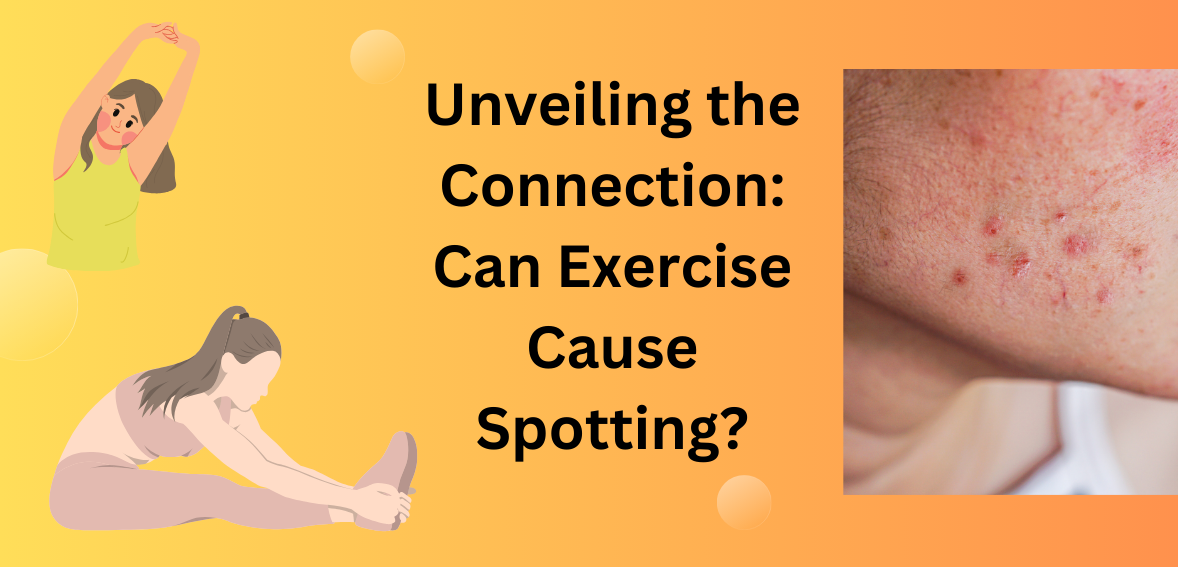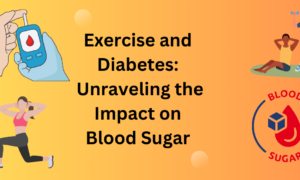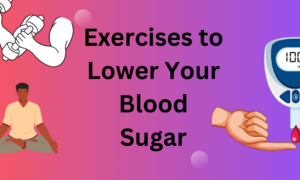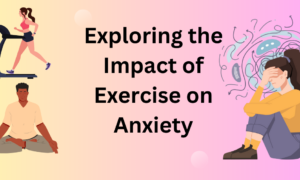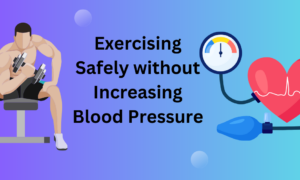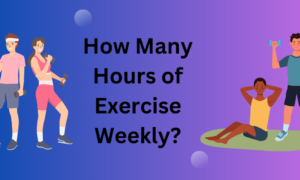Spotting during exercise can be quite alarming, especially if you’re not familiar with it. You may have experienced a sudden discharge of blood or light bleeding while engaging in physical activity and wondered, “Can exercise cause spotting?” Well, you’re not alone. Many individuals have raised this question due to the potential discomfort and concern it can cause. In this blog post, we’ll explore the link between exercise and spotting, discuss various types of exercises that may contribute to spotting, examine other factors that could play a role, offer tips for prevention or management, and help determine when it’s time to seek medical advice. So let’s dive in and get some clarity on this topic!
The link between exercise and spotting
Exercise is known to have numerous health benefits, from improving cardiovascular fitness to reducing stress. However, it’s not uncommon for women to experience spotting during or after exercise. While this can be concerning, it’s important to understand the possible link between exercise and spotting.
One potential cause of spotting during exercise is hormonal changes. Intense workouts can disrupt the delicate balance of hormones in your body, leading to irregular bleeding. Additionally, vigorous exercises like running or jumping can put pressure on the uterus and cervix, causing blood vessels to rupture and result in spotting.
Certain types of exercise are more likely to cause spotting than others. High-impact activities such as weightlifting or intense aerobic exercises tend to increase the risk of experiencing spotting. These activities place additional strain on pelvic organs and may trigger bleeding.
In addition to exercise itself, other factors may contribute to spotting during a workout session. For example, using certain medications like birth control pills that affect hormone levels can make you more prone to experiencing breakthrough bleeding while exercising.
It’s essential not only to listen but also to respond when your body sends signals that something isn’t right—spotting during exercise could indicate an underlying health issue that needs attention from a medical professional.
If you experience excessive or prolonged bleeding during or after exercising, accompanied by severe pain or any other unusual symptoms (e.g., dizziness), it’s crucial not to ignore them; seek prompt medical advice.
While there’s no foolproof way of preventing all instances of spotting during exercise, there are some steps you can take:
– Warming up properly before engaging in strenuous exercises
– Gradually increasing intensity instead of sudden bursts
– Avoiding high-intensity workouts if you’re already dealing with menstrual irregularities
– Wearing appropriate clothing and protective gear for comfort
Remember: staying active is important for overall well-being! If you notice any abnormal bleeding patterns while working out—or at any other time—don’t hesitate to seek medical advice for a proper evaluation and
Types of exercise that can cause spotting
1. High-intensity workouts: Exercises that involve intense movements and high impact, such as running, jumping jacks, or burpees, can put a strain on the body and potentially lead to spotting. The sudden increase in blood flow to the pelvic area during these activities may disrupt the delicate balance within the reproductive system.
2. Weightlifting: While weightlifting itself may not directly cause spotting, certain lifting techniques like heavy squats or deadlifts can temporarily increase intra-abdominal pressure. This pressure can place stress on the reproductive organs and potentially result in spotting.
3. Abdominal exercises: Engaging in rigorous abdominal exercises like sit-ups or crunches can also contribute to spotting. These movements create internal pressure within the abdomen and could disturb hormonal balance for some individuals.
4. Sudden changes in exercise routine: Any abrupt change in your workout routine, whether it’s increasing intensity or duration too quickly or starting a new type of exercise without proper conditioning, can disrupt your menstrual cycle and possibly lead to spotting.
5. High-impact sports: Sports with repetitive jumping motions like basketball or tennis often subject the pelvic region to increased stress and potential trauma from impacts with hard surfaces or falls. This physical strain could trigger bleeding between periods.
Remember that while these types of exercise have been associated with spotting in some cases, it doesn’t mean every individual will experience it. It’s important to listen to your body’s signals and make adjustments accordingly if you notice any abnormal bleeding during exercise sessions.
Other factors that may contribute to spotting during exercise
There are various factors other than exercise itself that can contribute to spotting during physical activity. While it’s important to note that spotting during exercise is not always a cause for concern, understanding these other factors can help shed light on why it may occur.
Hormonal fluctuations: Hormonal changes can play a significant role in spotting during exercise. For women, the menstrual cycle can bring about hormonal shifts that make them more susceptible to spotting. This is especially true around ovulation and before or after menstruation.
Stress and anxiety: Mental and emotional stressors can impact our bodies in unexpected ways, including causing irregularities in menstrual cycles. Stress-induced hormonal imbalances may lead to spotting during exercise.
Underlying health conditions: Certain medical conditions such as polycystic ovary syndrome (PCOS), uterine fibroids, endometriosis, or even thyroid disorders can increase the likelihood of experiencing intermenstrual bleeding while exercising.
Intense workouts: Engaging in high-intensity exercises or overexerting yourself physically can put additional strain on your body. This strain might disrupt normal hormone levels and potentially lead to mid-cycle bleeding.
Medication usage: Some medications like birth control pills or blood thinners might increase the chances of experiencing spotting during exercise due to their effects on hormones or blood clotting mechanisms.
It’s important to remember that every individual is unique, so what may trigger spotting for one person might not affect another in the same way. If you’re concerned about any abnormal bleeding patterns while exercising, it’s advisable to consult with a healthcare professional who can provide appropriate guidance based on your specific circumstances.
When to be concerned about spotting during exercise
While spotting during exercise can sometimes be a normal occurrence, there are certain situations where it is important to pay attention and potentially seek medical advice. It’s essential to listen to your body and understand what is considered normal for you.
If you experience heavy or prolonged spotting that lasts longer than a few days, this may warrant further investigation. Similarly, if the spotting becomes more frequent or occurs outside of your regular menstrual cycle, it could indicate an underlying issue that needs attention.
Additionally, if you notice any other unusual symptoms along with the spotting such as severe pain in your abdomen or pelvic area, dizziness, or fatigue, it’s crucial not to dismiss these signs and consult with a healthcare professional.
It’s also worth noting that if you have recently started a new exercise routine or have significantly increased the intensity of your workouts and begin experiencing spotting, it may be wise to take a break from exercising until you can speak with a doctor.
Remember that everyone’s body is different and what might be normal for one person may not be for another. Trust your instincts and seek advice when in doubt. Your health should always come first!
Tips for preventing or managing spotting during exercise
1. Listen to your body: Pay attention to any changes or discomfort during exercise, including spotting. If you experience spotting that is unusual or persistent, it’s important to listen to your body and seek medical advice.
2. Warm up properly: Before engaging in strenuous exercise, make sure to warm up properly. This helps increase blood flow and prepares your body for the workout ahead, potentially reducing the risk of spotting.
3. Stay hydrated: Drinking enough water before, during, and after exercise is crucial for overall health and can help prevent dehydration-related complications such as spotting.
4. Use proper technique: Ensure you are using proper form and technique while exercising. Incorrect movements or excessive strain on certain muscles may contribute to spotting.
5. Modify intensity if needed: If you notice an increase in spotting during high-intensity workouts, consider modifying the intensity level until the issue resolves. Gradually build up your stamina over time.
6. Rest when necessary: Allow yourself adequate rest days between workouts to allow your body time to recover and repair itself.
Remember that each person’s experience with exercise-induced spotting may vary, so it’s essential to consult with a healthcare professional for personalized advice based on your individual circumstances
Conclusion: Exercise is beneficial, but listen to your body and seek medical advice if needed
Exercise is undoubtedly beneficial for our overall health and well-being. It can improve cardiovascular fitness, strengthen muscles, boost mood, and even aid in weight loss. However, it’s important to listen to your body and pay attention to any unusual symptoms that may arise during exercise.
Spotting during exercise is not uncommon and can have various causes. Intense physical activity or certain types of exercises like running or weightlifting can put strain on the pelvic area and potentially lead to spotting. Hormonal fluctuations, such as those experienced during the menstrual cycle, can also contribute to spotting while exercising.
While spotting during exercise is often harmless and temporary, there are instances where it could be a cause for concern. If you experience excessive bleeding, severe pain, lightheadedness, dizziness or any other worrying symptoms along with spotting during exercise, it’s crucial to seek medical advice promptly.
To prevent or manage spotting during exercise:
1. Listen To Your Body: Pay attention to your body’s signals and don’t push yourself beyond your limits.
2. Use Proper Technique: Ensure you are using correct form when performing exercises to minimize unnecessary strain on the pelvic area.
3. Stay Hydrated: Dehydration can aggravate hormonal imbalances; make sure you drink enough water before, during, and after workouts.
4. Wear Appropriate Attire: Choose comfortable clothing that provides adequate support for your breasts and pelvic region.
5. Take Rest Days: Give your body sufficient time to recover between intense workout sessions.
6. Speak With A Healthcare Professional: If you consistently experience spotting or have concerns about it while exercising regularly.
In conclusion (pun intended), regular physical activity has numerous benefits for our bodies but understanding how our individual bodies respond is equally important – especially when it comes to unexpected occurrences such as spotting while exercising! By listening closely to our bodies’ cues we take care of ourselves holistically! So keep moving but always prioritize self-care and reach out to a healthcare professional if needed.

